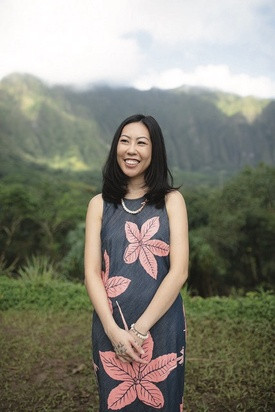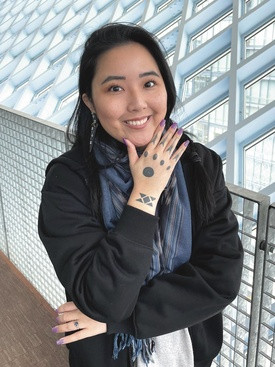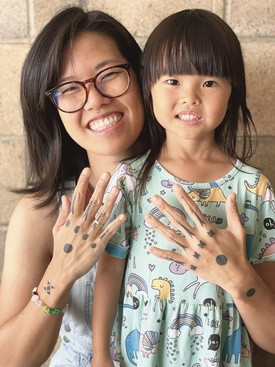Hand tattoos, once a subtle statement, have surged in popularity, becoming a powerful form of self-expression, especially among women. From delicate and minimalist designs to bold and intricate artwork, Female Hand Tattoos are capturing attention and sparking conversations. But the story of tattooing hands is richer and deeper than current trends suggest, rooted in ancient cultural practices and evolving meanings. One compelling example lies in the traditional Okinawan hajichi tattoos, a practice unique to women and deeply entwined with their heritage, identity, and societal roles. Exploring hajichi offers a fascinating glimpse into the historical significance of female hand tattoos and provides a rich context for understanding their modern resurgence.
The hajichi, traditional tattoos worn exclusively by women indigenous to Okinawa, Japan, offer a profound example of hand tattoos imbued with cultural weight. Esteemed Okinawan cultural expert, Eric Wada from Ukwanshin Kabudan, dedicated years to researching the motivations behind hajichi. According to Wada, oral traditions and limited documented information suggest hajichi existed pre-contact, evolving into a significant rite of passage for women entering adulthood. Beyond marking maturity, these tattoos held deep spiritual connections, linked to genealogy, cosmology, and even social status within Okinawan society. They were integral to a woman’s identity and her place within her community.
However, the narrative of hajichi took a tragic turn. As Wada explains, following the annexation of the Ryukyu Kingdom in 1879 and the subsequent imposition of Japanese assimilation programs, hajichi became a target of suppression. The Japanese government actively discouraged and eventually banned the practice, branding it as a “savage” custom in contrast to “modern” and “civilized” Japanese culture. This cultural assault led to Okinawan women, like the author’s great grandmother, feeling deep shame about their hajichi, a stark illustration of how external forces can transform symbols of pride into marks of stigma. The once celebrated hajichi became something to hide, leading some women to request being buried with gloves to conceal their tattoos, a poignant testament to the profound impact of cultural oppression.

The suppression of hajichi resulted in a dramatic decline in its practice. For decades, this art form faded, becoming so rare that younger generations in Okinawa grew up largely unaware of its existence. This near disappearance highlights the fragility of cultural traditions when faced with systematic suppression. Yet, in recent years, a remarkable revival of hajichi has emerged, signaling a renewed interest in cultural heritage and identity among Okinawan women. Wada expresses cautious optimism about this resurgence, acknowledging that while some may approach it as a fleeting trend, he observes a growing movement driven by a desire to reconnect with the deeper spiritual and cultural significance of hajichi. This revival reflects a broader trend of reclaiming cultural identity through body art, echoing in various communities around the world.
This resurgence of interest in hajichi and cultural tattoos aligns with the expanding landscape of modern female hand tattoos. Today, women are embracing hand tattoos for a myriad of reasons, drawing inspiration from diverse sources, including their own heritage. Unlike the imposed shame associated with hajichi in the past, contemporary female hand tattoos are often chosen as declarations of empowerment, individuality, and personal narratives. The hand, a highly visible and expressive part of the body, becomes a canvas for showcasing meaningful symbols, artistic designs, and personal stories.
Modern female hand tattoo designs are incredibly diverse, reflecting individual tastes and motivations. Small and delicate designs, such as minimalist lines, tiny flowers, or subtle geometric shapes, are popular choices for women seeking understated elegance. These designs can symbolize personal growth, resilience, or cherished memories, adding a layer of subtle meaning to everyday gestures. Floral and nature-inspired tattoos are also frequently seen on women’s hands, representing beauty, connection to nature, and personal growth. From roses and lilies to vines and leaves, these designs bring a touch of organic artistry to the hand.
Geometric and minimalist tattoos appeal to those who appreciate clean lines and modern aesthetics. These designs can range from simple shapes to intricate patterns, often carrying symbolic meanings related to balance, harmony, or personal philosophies. Words and meaningful symbols are also powerful choices for female hand tattoos. Whether it’s a single word representing a core value like “strength” or “love,” or a symbol with personal or cultural significance, these tattoos act as constant reminders of inner beliefs and connections. The placement on the hand itself can also contribute to the meaning, with finger tattoos offering a delicate and personal touch, while wrist and top-of-hand designs make bolder statements.

The stories of women choosing hand tattoos today often mirror the deeply personal motivations behind hajichi, albeit in a contemporary context. Consider the experiences of women like Sarah Tamashiro Kuaiwa, Rachel Miyazaki, and Mistee Uyehara, featured in the original article, who have embraced hajichi in its revival. While their specific cultural context is Okinawan, their motivations resonate with many women choosing hand tattoos today. Sarah, although not ethnically Okinawan, connected with hajichi through her adoptive family history and chose hand tattoos incorporating both Okinawan and Hawaiian elements to mark her academic pursuits and commitment to her community. Her story highlights how hand tattoos can symbolize personal journeys and cultural connections, blending heritage with individual expression.
Rachel Miyazaki, who is half Okinawan, sought hajichi as a way to connect with her Okinawan heritage and honor her ancestors. For Rachel, getting a hajichi tattoo filled a void in her understanding of her family history, becoming a tangible link to her roots. Her choice of the Naha style hajichi, based on her family’s origins, demonstrates the desire to personalize hand tattoos with culturally relevant designs, echoing the historical significance of hajichi patterns. Mistee Uyehara, who traveled to Okinawa to receive a traditional hand-poked hajichi, was inspired by the history, meaning, and strength embodied in this practice. Her detailed choice of symbols, researched with the help of hajichi experts, and her desire to share this tradition with her daughter underscore the enduring power of cultural heritage in shaping personal tattoo choices.

Choosing a female hand tattoo is a deeply personal decision. Beyond aesthetics, it involves considering design styles, placement, and personal meaning. The hand, being a sensitive area, can make the tattooing process more intense, so understanding pain tolerance is important. Aftercare is also crucial for hand tattoos, as hands are constantly in use and exposed to the elements. Finding a reputable and experienced tattoo artist is paramount, especially for intricate hand designs or those with cultural significance. Ultimately, the best female hand tattoo is one that resonates with the individual, reflecting her personality, story, and intentions. Whether inspired by ancient traditions like hajichi or contemporary trends, female hand tattoos offer a powerful avenue for self-expression and a beautiful way to adorn this expressive part of the body.
From the historical depths of hajichi to the diverse landscape of modern designs, female hand tattoos carry a rich tapestry of meaning. They are more than just skin art; they are symbols of cultural identity, personal journeys, empowerment, and self-expression. As women continue to embrace hand tattoos, they are not only adorning themselves with beautiful art but also participating in a long and evolving history of body modification, reclaiming their narratives, and making bold statements, one hand at a time.